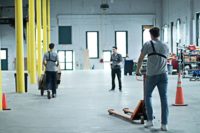Technology
COVID-19 technologies prove value beyond the pandemic

Last March, even the most experienced safety professionals couldn’t have foreseen what construction job sites would look like today. Along with the introduction of even more stringent safety protocols came a slew of new technologies. Most were designed to minimize the risk of exposure and transmission of COVID-19.
One of the more popular and cost effective options among the newer technologies are digital sign-in apps. These took off once it became clear that paper health screening sheets were unhealthy, inaccurate, time-consuming, and almost useless for contact tracing. Workers and visitors feel safer performing touchless check-ins using their own smartphones with a QR-coded poster. This also while reducing a contractor’s risks and protecting communities.
Today, a lot of these new protocols and technologies are providing value that goes beyond the pandemic. From a safety and compliance officer’s perspective, as well as the construction business owner, there’s a lot of upside to having streamlined check-ins that verify identities while protecting personal health information.
The immediate payoff is the ability to quickly and accurately perform contact tracing. While protecting employees is important anywhere, it’s especially true if your business is in a state that requires rapid notification of a work-related outbreak. For example, in California, the new AB685 law mandates notification within 48 hours.
Change in policies
According to Rod Courtney, health, safety, and environmental manager at Ampirical Solutions, “We’re in the electrical transmission business so safety is the one area where risks and compromise aren’t tolerated.”
When the COVID-19 pandemic first hit, Ampirical, like many companies, initiated policies for onsite employees based on CDC guidelines. Employees reporting to the office or a construction site were not allowed to enter without first having their temperatures taken. To do this, Ampirical uses a standalone unit that takes employee temperatures and connects the data to HR and building security. This same system also offers facial recognition so that employees and visitors can be tracked to the point of entry, which is critical if they are showing COVID-19 symptoms. Such technology is expensive, but Ampirical’s field sites are semi-permanent, so the costs can be amortized over time and multiple projects. Ampirical also relies on a digital check in app for health screenings and contact tracing for both field and headquarters locations.
Longer-term benefits of digital check-ins are starting to emerge, because there’s a lot of insight to be gained knowing when workers or visitors step onto a site in near real-time. Applying analytics to check in data can spot employee attendance and performance trends. The digital records of who is onsite and where they’re located is useful in the event of an emergency. For site supervisors, the data helps with union and OSHA record keeping. It also gives project managers the insight they need to proactively spot potential delays.
Evolving apps
From a compliance perspective, the unbiased digital records that come in handy if anything goes awry on a job site. But as these apps evolve, they’re starting to include job assignments and therefore automate the collection of daily logs. For example, when a worker shows up, they can select from a list of assignments that they’ll be working on, such as drywall or tiling. They might also select the specific area where they’ll be working onsite and the name of their onsite supervisor.
Combined, these data points tell several business stories allowing more remote site management and better HQ/field coordination, all of which leads to better productivity and profitability.
While we’re getting closer to the end of the pandemic, the drastic shifts in job site protocols have forced all of us to rethink how we go about our activities. One silver lining is the increased focus on digital check ins and health screenings. These apps will become part of the routine, replacing sign in logs and visitor books, and giving employers another dimension of critical insight into their business.
Looking for a reprint of this article?
From high-res PDFs to custom plaques, order your copy today!






